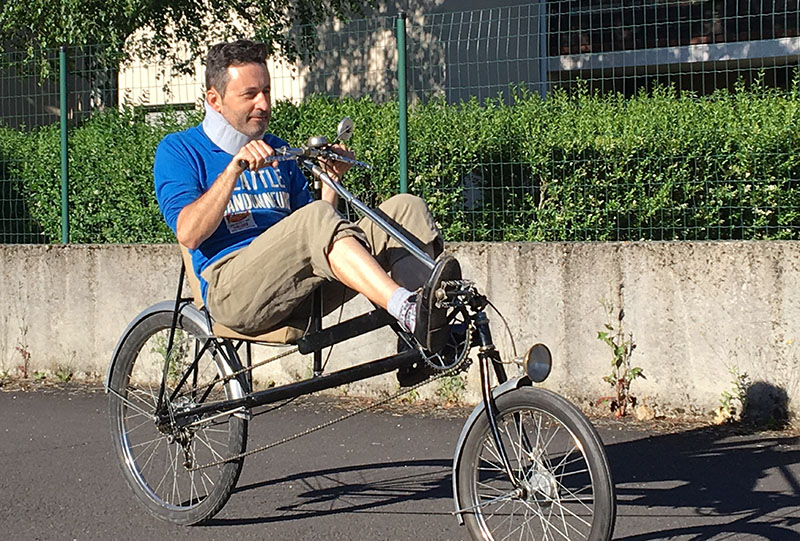Riding the First Recumbent

Bicycle Quarterly hasn’t really covered recumbents much. It’s not that we aren’t interested, it just seems difficult to do such totally different machines justice. And yet recumbents are a perfect fit with Bicycle Quarterly‘s research into the history of cyclotouring. During the mid-1930s, recumbents were quite popular among French cyclotourists.

Many saw them as the bikes of the future. While the racing world outlawed recumbents soon after Francis Faure set an hour record on a recumbent in 1933, cyclotourists and randonneurs couldn’t have cared less about what the Union Cycliste Internationale (UCI) thought: That recumbents weren’t “real” bicycles.
Recumbents appealed to “real-world” riders because they seemed to offer speed and comfort, in addition to novelty. Quite a few companies offered them: Mochet, Ravat, Vélostable… They even participated in the 1930s Technical Trials, where they were given their own category, because they couldn’t compete on weight with upright bicycles. Randonneurs in Paris-Brest-Paris were allowed to ride them, too. And for a while, recumbents received a lot of positive press.
But then they faded away. By the late 1930s, almost half of the “for sale” ads in magazines like Le Cycliste listed recumbents. I’ve often wondered: What happened?
The literature is silent on this issue – they just stopped talking about recumbents. Most riders who rode recumbents back then unfortunately no longer are with us. The best way to understand 1930s recumbents today is to ride one.

Imagine my excitement when Christophe Courbou, the organizer of the French Technical Trials, showed me his latest find: a mid-1930s Mochet Vélo-Vélocar. Mochet was the brand that started the recumbent craze of the 1930s. His machine was ridden to that infamous hour record.
Georges Mochet first developed a four-wheeled, pedal-powered car, the Vélocar. This became quite popular – people even rode across the country in them. Then Mochet had the idea of cutting the car in half, and making a bicycle out of it. Hence the strange name: Vélo-Vélocar. (It’s the bike version of the Bike Car.)
“Can I ride it?” was my immediate question. Classic bikes fascinate me, but I am not a collector. I want to ride them: How do they work? What are their strenghts and weak points? What can we learn from them. Could this be another forgotten gem like the 650B randonneur bikes that we discovered in the dusty annals of history?

Fortunately, Christophe’s Mochet remains in perfect condition. It clearly hasn’t been ridden a lot. Unfortunately for me, I am too tall for the bike. The size can be adjusted, but this requires a lot of work, including lengthening the chain. After the Technical Trials, there simply wasn’t enough time for this.
So I tried to ride the Mochet as is. I had to splay my legs to clear the handlebars. And I found I couldn’t keep the bike upright.
Perhaps I was too tired from riding that day’s gravel stage of the Technical Trials. Having to keep my knees from hitting the handlebars (which immediately turned them sharply) didn’t help. I am glad nobody photographed my attempts: They were too busy catching me as I kept falling over!

Christophe has more practice, and he managed to ride the Mochet impressively well. But even he wasn’t keen on heading into the surrounding hills to try the Mochet on steep ups and downs.
The problem seems to stem from the universal joint in the steering. It’s beautifully made, just like the rest of the bike, and it turns very smoothly. But the handlebars only have an indirect connection to the front wheel.
On an “upright” bicycle, you simply look where you want to go, and the bike follows. On the Mochet and similar 1930s recumbents, you have to think about where you turn the handlebars and how far. That active thought process made it so difficult for me to ride the Mochet. It apparently takes a while to become intuitive. I can’t imagine that you’ll ever get the same feedback about what your contact patches are doing as you do on a “regular” bike.
Christophe also reports that sitting on the Mochet isn’t very comfortable – recumbent seats have come a long way since 1933. When you consider how highly evolved the best French cyclotouring bikes already were in the 1930s, it’s no wonder the recumbents didn’t really catch on. They clearly needed more development before they’d become viable alternatives to “upright” bikes.

So we now know that it wasn’t the UCI banning recumbents that caused their fall from popularity. The machines simply didn’t work well enough. The riders who bought them, often sold them after the novelty had worn off.
And yet – I want to try one for a longer ride. The old photo of the touring countryside is just too evocative. Christophe has promised that the next time I visit, we’ll fit the Mochet to my taller body, and then I can have a go. I can’t wait!
Further reading:
- Fascinating newsreel footage of 1930s cycling, including recumbents.
- Bicycle Quarterly 23 had a feature on a 1930s Vélostable recumbent.


